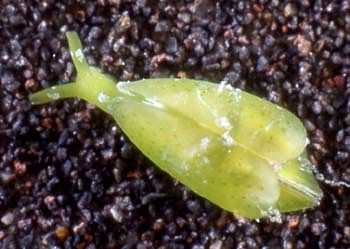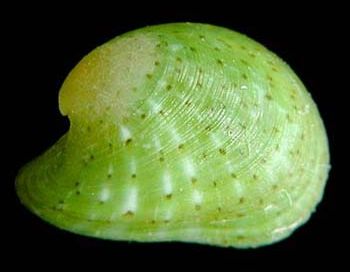Hawaiian Julia exquisita
October 12, 2001
From: Cory Pittman


On Maui, Hawaiian Ids, shells of Julia exquisita (Gould, 1862) are common in sand samples that include material from shallow, moderately exposed to exposed, rocky habitats. All told, I've seen several thousand valves with a maximum shell length of 5.2 mm. I've also picked up 12 live animals in algae washes from depths of less than 1 m to 3 m. The background color ranges from green to straw and the exterior is marked by radiating rows of brown or dark green spots, each with a cloudy white "halo" extending dorsally. The size of the spots and number of rows is highly variable but the general pattern is consistent. Rarely, shells may lack spots completely. In living animals, the body is green with scattered white flecks. The hinge is large and the central, tooth-like knob is oval in cross section with a "bean-shaped" apex.
Julia japonicum Kuroda & Habe, 1951 is apparently closely related based on photos and shells that Terry Gosliner showed me when I visited the California Academy of Sciences.
I've found shells in sand samples (sent to me by Pauline Fiene-Severns and Jerry Flora) from Midway Atoll, Raratonga and Magaia(Cook Islands).
The live shot is of a 3.5 mm animal collected in an algae wash at Hekili Point, Maui on October 14, 1997. It was at a depth of less than 1 m. The shell photos [see separate message] are of a hinged pair, 4.5 mm in length. It was in a "random bottle" rather than one of my quantitative samples but was probably found in beach drift at Maalaea Bay, Maui.
Cory Pittman
cory@cet.com
Pittman, C., 2001 (Oct 12) Hawaiian Julia exquisita. [Message in] Sea Slug Forum. Australian Museum, Sydney. Available from http://www.seaslugforum.net/find/5372Related messages
-
Julia exquisita found in my tank
From: Andy Jukes, August 14, 2006 -
The bivalved sacoglossan genus Julia in Hawaii
From: Cory Pittman, October 12, 2001 -
Shell of Julia exquisita
From: Cory Pittman, October 12, 2001 -
The bivalved sacoglossan Julia exquisita
From: Bill Rudman, July 21, 1999
